Decision-Making for Sustainable Digitalization Through Grey Systems Theory: A Bibliometric Overview
Abstract
1. Introduction
- RQ1: What is the trend of the production of papers in this field?
- RQ2: What are the authors, journals, and countries with the most relevant contribution to the production of papers in the field and how is the collaboration network between countries?
- RQ3: What are the main topics addressed by the articles on the theory of Grey systems, digitalization, and sustainability?
2. Materials and Methods
3. Dataset Investigation
3.1. Dataset Analysis
3.2. Source Analysis
3.3. Author Analysis
3.4. Country Analysis
3.5. Most-Cited Document Analysis
3.6. Mixed Analysis
4. Discussion and Limitations
4.1. Bibliometric Results Discussion
4.2. Discussion Based on Investigated Themes
4.3. Bibliometric Limitations
5. Conclusions
- In terms of scientific output in the field, the investigation revealed that the trend is predominantly upward, confirming the increasing research interest in the field. Thus, the first hypothesis H1 was confirmed. The analyzed data revealed a wide range of fluctuations in the number of published papers; the sharpest increases and decreases occurred at the end of the analyzed period, as there was a significant increase in the volume of articles from 2015 to 2018, followed by a sharp decline from 2018; similarly, there was a noticeable increase until 2023, followed by an overall decrease.
- The most relevant authors in terms of number of papers published in the 1997–2024 timespan are as follows: Rajesh R (eight papers), Ali SM (7 papers), Ferasso M, Ikram M, Karuppiah K, Kokocinska M, Liu SF, Nowak M, Paul SK, Sankaranarayanan B, all with three published papers each. The country analysis revealed the following top-down ranking in terms of the contribution in researching the implications of Grey systems theory in sustainable digitalization: China with 83 published papers and a total of 1731 citations, India with 26 papers and 600 citations, Poland with 6 papers and 123 citations, Iran with 5 published papers and 112 citations, USA with a total of 4 papers and 649 citations, Bangladesh with 3 papers and 50 citations, Brazil with 3 papers and 28 citations, Turkey with 3 papers and 92 citations, Australia with 2 papers and 248 citations, and Chile with 2 papers and a total of 3 citations. Based on these findings, the second hypothesis H2 was also confirmed, since Asian countries (especially China), have the greatest contribution in researching the implications of Grey systems theory in sustainable digitalization through published papers and total citations in the field. Moreover, when considering international cooperation, it is important to note that China and India, the two nations with the greatest relevant contributions, prefer the publication of SCP-type papers. Nevertheless, when it comes to collaborating closely as a whole, China, India, the United States, Brazil, Australia, and Chile have the strongest connections.
- The most popular topics in the study of this subject mainly include the themes “Sustainable development”, “Supply chain”, “Supplier selection”, “Digital economy”, “Grey system”, “Success factors”, and “Sustainable supplier selection”. Besides the motor themes that are most commonly tackled in the scientific output, as they describe applications and methods of the implementation of Grey systems theory models, we particularly point towards the niche and the emerging themes in the field through thematic mapping. As niche themes, we highlight the focus on the energy domain, as CO2 emissions and energy-consumption in the energy sector turned out to benefit from special attention in the literature review and could thus be further explored in terms of policy recommendations and implications upon economic development, the business sector, and the academic field. Thus, studying the decision-making processes of digitalization through the Grey systems theory by incorporating the environmental component represents more of a niche thematic approach in the field. Moreover, the thematic map identifies, as emerging themes, the focus on prediction, growth, and innovation. These items describe the potential growth of the domain, thanks to the innovation process, while focusing on the prediction ability of the Grey systems models. Therefore, future publications that tackle the decision-making of sustainable digitalization through Grey systems theory will focus more on testing the reliability and applicability of the decision-making models that should accurately predict the outcome of the policy implementation. Our factorial analysis indicated some possible areas that are frequently influenced by sustainable policies, such as the supply chain and the level of production.
Author Contributions
Funding
Institutional Review Board Statement
Informed Consent Statement
Data Availability Statement
Conflicts of Interest
References
- European Commission. A Digital Agenda for Europe; Publications Office of the European Union: Luxembourg, 2010. [Google Scholar]
- European Commission. A Europe Fit for the Digital Age; Publications Office of the European Union: Luxembourg, 2020. [Google Scholar]
- Crisan, G.-A.; Cristescu, A.; Popescu, M.E. Shaping the Digital Labor Market in the European Union. Theor. Appl. Econ. 2024, 31, 201–210. [Google Scholar]
- Xu, G.; Lu, T.; Chen, X.; Liu, Y. The Convergence Level and Influencing Factors of China’s Digital Economy and Real Economy Based on Grey Model and PLS—SEM. J. Intell. Fuzzy Syst. 2021, 42, 1–31. [Google Scholar] [CrossRef]
- Domański, R.; Wojciechowski, H.; Lewandowicz, J.; Hadaś, Ł. Digitalization of Management Processes in Small and Medium-Sized Enterprises—An Overview of Low-Code and No-Code Platforms. Appl. Sci. 2023, 3, 13078. [Google Scholar] [CrossRef]
- Crisan, G.-A.; Popescu, M.E.; Militaru, E.; Cristescu, A. EU Diversity in Terms of Digitalization on the Labor Market in the Post-COVID-19 Context. Economies 2023, 11, 293. [Google Scholar] [CrossRef]
- Transforming Our World: The 2030 Agenda for Sustainable Development | Department of Economic and Social Affairs. Available online: https://sdgs.un.org/2030agenda (accessed on 7 January 2025).
- Sultanova, G.K.; Djuraeva, R.A.; Turaeva, S.T. The Impact of the Digital Economy on Renewable Energy Consumption and Generation: Evidence from European Union Countries. In Proceedings of the 6th International Conference on Future Networks & Distributed Systems; Tashkent, Uzbekistan, 15 December 2022, Association for Computing Machinery: New York, NY, USA; pp. 99–109.
- Li, X.; Liu, J.; Ni, P. The Impact of the Digital Economy on CO2 Emissions: A Theoretical and Empirical Analysis. Sustainability 2021, 13, 7267. [Google Scholar] [CrossRef]
- Ju-Long, D. Control Problems of Grey Systems. Syst. Control Lett. 1982, 1, 288–294. [Google Scholar] [CrossRef]
- Wu, W.-Y.; Chen, S.-P. A Prediction Method Using the Grey Model GMC(1, n) Combined with the Grey Relational Analysis: A Case Study on Internet Access Population Forecast. Appl. Math. Comput. 2005, 169, 198–217. [Google Scholar] [CrossRef]
- Xiao, Q.; Gao, M.; Chen, L.; Jiang, J. Dynamic Multi-Attribute Evaluation of Digital Economy Development in China: A Perspective from Interaction Effect. Technol. Econ. Dev. Econ. 2023, 29, 1728–1752. [Google Scholar] [CrossRef]
- Camelia, D. Grey Systems Theory in Economics—A Historical Applications Review. Grey Syst. Theory Appl. 2015, 5, 263–276. [Google Scholar] [CrossRef]
- Jiang, P.; Zhaohu, D.; Sun, H.; Song, Y.; Zou, Q. Grey System Theory in Supply Chain: Emerging Hotspots and Trends. Grey Syst. Theory Appl. 2025, 15, 124–144. [Google Scholar] [CrossRef]
- Delcea, C.; Cotfas, L.-A. Supplier Selection Using Grey Systems Theory. In Advancements of Grey Systems Theory in Economics and Social Sciences; Springer Nature: Singapore, 2023; pp. 85–138. ISBN 978-981-19-9931-4. [Google Scholar]
- Delcea, C.; Cotfas, L.-A. State of the Art in Grey Systems Research in Economics and Social Sciences. In Advancements of Grey Systems Theory in Economics and Social Sciences; Springer Nature: Singapore, 2023; pp. 1–44. ISBN 978-981-19-9931-4. [Google Scholar]
- Delcea, C.; Javed, S.A.; Florescu, M.-S.; Ioanas, C.; Cotfas, L.-A. 35 Years of Grey System Theory in Economics and Education. Kybernetes 2023, 54, 649–683. [Google Scholar] [CrossRef]
- Domenteanu, A.; Crișan, G.-A.; Frăsineanu, C.; Delcea, C. Exploring Grey Systems in Uncertain Environments: A Bibliometric Analysis of Global Contributions and Research Themes. Sustainability 2025, 17, 2764. [Google Scholar] [CrossRef]
- Sandu, A.; Diaconu, P.; Delcea, C.; Domenteanu, A. Emphasizing Grey Systems Contribution to Decision-Making Field Under Uncertainty: A Global Bibliometric Exploration. Mathematics 2025, 13, 1278. [Google Scholar] [CrossRef]
- Tao, L.; Liang, A.; Xie, N.; Liu, S. Grey System Theory in Engineering: A Bibliometrics and Visualization Analysis. Grey Syst. Theory Appl. 2022, 12, 723–743. [Google Scholar] [CrossRef]
- WoS Web of Science. Available online: http://webofknowledge.com (accessed on 10 January 2024).
- Bakır, M.; Özdemir, E.; Akan, Ş.; Atalık, Ö. A Bibliometric Analysis of Airport Service Quality. J. Air Transp. Manag. 2022, 104, 102273. [Google Scholar] [CrossRef]
- Domenteanu, A.; Cotfas, L.-A.; Diaconu, P.; Tudor, G.-A.; Delcea, C. AI on Wheels: Bibliometric Approach to Mapping of Research on Machine Learning and Deep Learning in Electric Vehicles. Electronics 2025, 14, 378. [Google Scholar] [CrossRef]
- Sandu, A.; Cotfas, L.-A.; Delcea, C.; Ioanăș, C.; Florescu, M.-S.; Orzan, M. Machine Learning and Deep Learning Applications in Disinformation Detection: A Bibliometric Assessment. Electronics 2024, 13, 4352. [Google Scholar] [CrossRef]
- Sandu, A.; Cotfas, L.-A.; Stănescu, A.; Delcea, C. Guiding Urban Decision-Making: A Study on Recommender Systems in Smart Cities. Electronics 2024, 13, 2151. [Google Scholar] [CrossRef]
- Întorsureanu, I.; Oprea, S.-V.; Bâra, A.; Vespan, D. Generative AI in Education: Perspectives Through an Academic Lens. Electronics 2025, 14, 1053. [Google Scholar] [CrossRef]
- Oprea, S.-V.; Bâra, A. Generative Literature Analysis on the Rise of Prosumers and Their Influence on the Sustainable Energy Transition. Util. Policy 2024, 90, 101799. [Google Scholar] [CrossRef]
- Oprea, S.-V.; Bâra, A. Is Artificial Intelligence a Game-Changer in Steering E-Business into the Future? Uncovering Latent Topics with Probabilistic Generative Models. J. Theor. Appl. Electron. Commer. Res. 2025, 20, 16. [Google Scholar] [CrossRef]
- Liu, W. The Data Source of This Study Is Web of Science Core Collection? Not Enough. Scientometrics 2019, 121, 1815–1824. [Google Scholar] [CrossRef]
- Liu, F. Retrieval Strategy and Possible Explanations for the Abnormal Growth of Research Publications: Re-Evaluating a Bibliometric Analysis of Climate Change. Scientometrics 2023, 128, 853–859. [Google Scholar] [CrossRef]
- Cobo, M.J.; López-Herrera, A.G.; Herrera-Viedma, E.; Herrera, F. Science Mapping Software Tools: Review, Analysis, and Cooperative Study among Tools. J. Am. Soc. Inf. Sci. Technol. 2011, 62, 1382–1402. [Google Scholar] [CrossRef]
- Zupic, I.; Čater, T. Bibliometric Methods in Management and Organization. Organ. Res. Methods 2015, 18, 429–472. [Google Scholar] [CrossRef]
- Delcea, C.; Oprea, S.-V.; Dima, A.M.; Domenteanu, A.; Bara, A.; Cotfas, L.-A. Energy Communities: Insights from Scientific Publications. Oeconomia Copernic. 2024, 15, 1101–1155. [Google Scholar] [CrossRef]
- Domenteanu, A.; Crisan, G.-A.; Popescu, M.E.; Delcea, C. The Impact of Digitalization on Air Traffic Evolution and Measures of Reducing Co2 Emissions. Proc. Int. Conf. Bus. Excell. 2024, 18, 3430–3442. [Google Scholar] [CrossRef]
- Yin, M.-S. Fifteen Years of Grey System Theory Research: A Historical Review and Bibliometric Analysis. Expert Syst. Appl. 2013, 40, 2767–2775. [Google Scholar] [CrossRef]
- Mahala, A.; Dwivedi, G.; Tripathi, M. A Bibliometric Study of Grey Literature (2007–2019). Collect. Curation 2020, 40, 128–137. [Google Scholar] [CrossRef]
- Camelia, D. Grey Systems Theory in Economics—Bibliometric Analysis and Applications’ Overview. Grey Syst. Theory Appl. 2015, 5, 244–262. [Google Scholar] [CrossRef]
- Thangavel, P.; Chandra, B. Two Decades of M-Commerce Consumer Research: A Bibliometric Analysis Using R Biblioshiny. Sustainability 2023, 15, 11835. [Google Scholar] [CrossRef]
- Ayodele, B.V.; Mustapa, S.I. Life Cycle Cost Assessment of Electric Vehicles: A Review and Bibliometric Analysis. Sustainability 2020, 12, 2387. [Google Scholar] [CrossRef]
- Sharma, G.; Reppas, D.; Muschert, G.; Pereira, V. Investigating Digital Sustainability: A Retrospective Bibliometric Analysis of Literature Leading to Future Research Directions. First Monday 2021, 26. [Google Scholar] [CrossRef]
- Alqasemi, F.; Al-Hagree, S.; Shaddad, R.Q.; Zahary, A.T. An IEEE Xplore Database Literature Review Concerning Internet of Everything During 2020–2021. In Proceedings of the 2021 International Conference on Intelligent Technology, System and Service for Internet of Everything (ITSS-IoE), Sanaa, Yemen, 1–2 November 2021. [Google Scholar]
- Wardikar, V. Application of Bradford’s Law of Scattering to the Literature of Library & Information Science: A Study of Doctoral Theses Citations Submitted to the Universities of Maharashtra, India. Libr. Philos. Pract. (E-J.) 2013, 1054. [Google Scholar]
- Yang, J.-M.; Tseng, S.-F.; Won, Y.-L. A Bibliometric Analysis on Data Mining Using Bradford’s Law. In Proceedings of the 3rd International Conference on Intelligent Technologies and Engineering Systems; Springer: Berlin/Heidelberg, Germany, 2016; pp. 613–620, ISBN 978-3-319-17313-9. [Google Scholar]
- Moktadir, M.A.; Ali, S.M.; Rajesh, R.; Paul, S.K. Modeling the Interrelationships among Barriers to Sustainable Supply Chain Management in Leather Industry. J. Clean. Prod. 2018, 181, 631–651. [Google Scholar] [CrossRef]
- Rajagopal, R. Optimal Trade-Offs in Decision-Making for Sustainability and Resilience in Manufacturing Supply Chains. J. Clean. Prod. 2021, 313, 127596. [Google Scholar] [CrossRef]
- Rajesh, R. Exploring the Sustainability Performances of Firms Using Environmental, Social, and Governance Scores. J. Clean. Prod. 2020, 247, 119600. [Google Scholar] [CrossRef]
- Karuppiah, K.; Sankaranarayanan, B.; Ali, S.M.; Jabbour, C.J.C.; Bhalaji, R.K.A. Inhibitors to Circular Economy Practices in the Leather Industry Using an Integrated Approach: Implications for Sustainable Development Goals in Emerging Economies. Sustain. Prod. Consum. 2021, 27, 1554–1568. [Google Scholar] [CrossRef]
- Nasir, S.B.; Ahmed, T.; Karmaker, C.L.; Ali, S.M.; Paul, S.K.; Majumdar, A. Supply Chain Viability in the Context of COVID-19 Pandemic in Small and Medium-Sized Enterprises: Implications for Sustainable Development Goals. J. Enterp. Inf. Manag. 2021, 35, 100–124. [Google Scholar] [CrossRef]
- Newby, G.; Greenberg, J.; Jones, P. Open Source Software Development and Lotka’s Law: Bibliometric Patterns in Programming. JASIST 2003, 54, 169–178. [Google Scholar] [CrossRef]
- Bai, C.; Sarkis, J. Integrating Sustainability into Supplier Selection with Grey System and Rough Set Methodologies. Int. J. Prod. Econ. 2010, 124, 252–264. [Google Scholar] [CrossRef]
- Su, C.-M.; Horng, D.-J.; Tseng, M.-L.; Chiu, A.S.F.; Wu, K.-J.; Chen, H.-P. Improving Sustainable Supply Chain Management Using a Novel Hierarchical Grey-DEMATEL Approach. J. Clean. Prod. 2016, 134, 469–481. [Google Scholar] [CrossRef]
- Wu, K.-J.; Liao, C.-J.; Tseng, M.-L.; Lim, M.K.; Hu, J.; Tan, K. Toward Sustainability: Using Big Data to Explore the Decisive Attributes of Supply Chain Risks and Uncertainties. J. Clean. Prod. 2017, 142, 663–676. [Google Scholar] [CrossRef]
- Luthra, S.; Mangla, S.K.; Shankar, R.; Garg, C.P.; Jakhar, S. Modelling Critical Success Factors for Sustainability Initiatives in Supply Chains in Indian Context Using Grey-DEMATEL. Prod. Plan. Control 2018, 29, 1–24. [Google Scholar] [CrossRef]
- Golinska, P.; Kosacka, M.; Mierzwiak, R.; Werner-Lewandowska, K. Grey Decision Making as a Tool for the Classification of the Sustainability Level of Remanufacturing Companies. J. Clean. Prod. 2015, 105, 28–40. [Google Scholar] [CrossRef]
- Zarbakhshnia, N.; Wu, Y.; Govindan, K.; Soleimani, H. A Novel Hybrid Multiple Attribute Decision-Making Approach for Outsourcing Sustainable Reverse Logistics. J. Clean. Prod. 2020, 242, 118461. [Google Scholar] [CrossRef]
- Dong, L.; Deng, S.; Wang, F. Some Developments and New Insights for Environmental Sustainability and Disaster Control of Tailings Dam. J. Clean. Prod. 2020, 269, 122270. [Google Scholar] [CrossRef]
- Wilczewski, M.; Alon, I. Language and Communication in International Students’ Adaptation: A Bibliometric and Content Analysis Review. High. Educ. 2023, 85, 1235–1256. [Google Scholar] [CrossRef]
- Pan, W.; Jian, L.; Liu, T. Grey System Theory Trends from 1991 to 2018: A Bibliometric Analysis and Visualization. Scientometrics 2019, 121, 1407–1434. [Google Scholar] [CrossRef]
- Fang, H.; Fang, F.; Hu, Q.; Wan, Y. Supply Chain Management: A Review and Bibliometric Analysis. Processes 2022, 10, 1681. [Google Scholar] [CrossRef]
- Delcea, C.; Cotfas, L.-A. Hybrid Approaches Featuring Grey Systems Theory. In Advancements of Grey Systems Theory in Economics and Social Sciences; Springer: Berlin/Heidelberg, Germany, 2023; pp. 281–333. ISBN 978-981-19-9931-4. [Google Scholar]
- Javanmardi, E.; Liu, S.; Xie, N. Exploring Grey Systems Theory-Based Methods and Applications in Sustainability Studies: A Systematic Review Approach. Sustainability 2020, 12, 4437. [Google Scholar] [CrossRef]
- Javanmardi, E.; Liu, S.; Xie, N. Exploring the Challenges to Sustainable Development from the Perspective of Grey Systems Theory. Systems 2023, 11, 70. [Google Scholar] [CrossRef]
- Diba, S.; Xie, N. Sustainable Supplier Selection for Satrec Vitalait Milk Company in Senegal Using the Novel Grey Relational Analysis Method. Grey Syst. Theory Appl. 2019, 9, 262–294. [Google Scholar] [CrossRef]
- Ali, S.M.; Rahman, A.U.; Kabir, G.; Paul, S.K. Artificial Intelligence Approach to Predict Supply Chain Performance: Implications for Sustainability. Sustainability 2024, 16, 2373. [Google Scholar] [CrossRef]
- Karuppiah, K.; Sankaranarayanan, B.; Ali, S.M. On Sustainable Predictive Maintenance: Exploration of Key Barriers Using an Integrated Approach. Sustain. Prod. Consum. 2021, 27, 1537–1553. [Google Scholar] [CrossRef]
- Abid, N.; Ikram, M.; Wu, J.; Ferasso, M. Towards Environmental Sustainability: Exploring the Nexus among ISO 14001, Governance Indicators and Green Economy in Pakistan. Sustain. Prod. Consum. 2021, 27, 653–666. [Google Scholar] [CrossRef]
- Ikram, M.; Zhang, Q.; Sroufe, R.; Ferasso, M. Contribution of Certification Bodies and Sustainability Standards to Sustainable Development Goals: An Integrated Grey Systems Approach. Sustain. Prod. Consum. 2021, 28, 326–345. [Google Scholar] [CrossRef]
- Ikram, M.; Sroufe, R.; Zhang, Q.; Ferasso, M. Assessment and Prediction of Environmental Sustainability: Novel Grey Models Comparative Analysis of China vs. the USA. Environ. Sci. Pollut. Res. 2021, 28, 17891–17912. [Google Scholar] [CrossRef]
- Nowak, M.; Kokocińska, M. The Efficiency of Economic Growth for Sustainable Development—A Grey System Theory Approach in the Eurozone and Other European Countries. Sustainability 2024, 16, 1839. [Google Scholar] [CrossRef]
- Kokocińska, M.; Nowak, M.; Łopatka, P. Measuring the Efficiency of Economic Growth towards Sustainable Growth with Grey System Theory. Sustainability 2020, 12, 10121. [Google Scholar] [CrossRef]
- Nowak, M.; Kokocińska, M. Efficiency Ranking of Economic Growth toward Sustainable Growth with Grey System Theory: The Case of Small Countries in Advanced and Emerging Economies. Int. J. Manag. Econ. 2023, 59, 183–196. [Google Scholar] [CrossRef]
- Liang, H.; Ren, J.; Gao, Z.; Gao, S.; Luo, X.; Dong, L.; Scipioni, A. Identification of Critical Success Factors for Sustainable Development of Biofuel Industry in China Based on Grey Decision-Making Trial and Evaluation Laboratory (DEMATEL). J. Clean. Prod. 2016, 131, 500–508. [Google Scholar] [CrossRef]
- Ren, J.; Liang, H.; Dong, L.; Gao, Z.; He, C.; Pan, M.; Sun, L. Sustainable Development of Sewage Sludge-to-Energy in China: Barriers Identification and Technologies Prioritization. Renew. Sustain. Energy Rev. 2017, 67, 384–396. [Google Scholar] [CrossRef]
- Bai, C.; Fahimnia, B.; Sarkis, J. Sustainable Transport Fleet Appraisal Using a Hybrid Multi-Objective Decision Making Approach. Ann. Oper. Res. 2017, 250, 309–340. [Google Scholar] [CrossRef]
- Bai, C.; Sarkis, J. Integrating Sustainability into Supplier Selection: A Grey-Based TOPSIS Analysis. Technol. Econ. Dev. Econ. 2018, 24, 2202–2224. [Google Scholar] [CrossRef]
- Dai, S.; Niu, D.; Han, Y. Forecasting of Energy-Related CO2 Emissions in China Based on GM(1,1) and Least Squares Support Vector Machine Optimized by Modified Shuffled Frog Leaping Algorithm for Sustainability. Sustainability 2018, 10, 958. [Google Scholar] [CrossRef]
- Niu, D.; Li, Y.; Dai, S.; Kang, H.; Xue, Z.; Jin, X.; Song, Y. Sustainability Evaluation of Power Grid Construction Projects Using Improved TOPSIS and Least Square Support Vector Machine with Modified Fly Optimization Algorithm. Sustainability 2018, 10, 231. [Google Scholar] [CrossRef]
- Vachon, S.; Mao, Z. Linking Supply Chain Strength to Sustainable Development: A Country-Level Analysis. J. Clean. Prod. 2008, 16, 1552–1560. [Google Scholar] [CrossRef]
- Chauhan, C.; Kaur, P.; Arrawatia, R.; Ractham, P.; Dhir, A. Supply Chain Collaboration and Sustainable Development Goals (SDGs). Teamwork Makes Achieving SDGs Dream Work. J. Bus. Res. 2022, 147, 290–307. [Google Scholar] [CrossRef]
- Si, S.-L.; You, X.-Y.; Liu, H.-C.; Zhang, P. DEMATEL Technique: A Systematic Review of the State-of-the-Art Literature on Methodologies and Applications. Math. Probl. Eng. 2018, 2018, 3696457. [Google Scholar] [CrossRef]
- Mahmoudi, A.; Deng, X.; Javed, S.A.; Zhang, N. Sustainable Supplier Selection in Megaprojects: Grey Ordinal Priority Approach. Bus. Strategy Environ. 2021, 30, 318–339. [Google Scholar] [CrossRef]
- Hu, M.; Liu, W. Grey System Theory in Sustainable Development Research—A Literature Review (2011−2021). Grey Syst. Theory Appl. 2022, 12, 785–803. [Google Scholar] [CrossRef]
- Delcea, C.; Cotfas, L.-A.; Paun, R. Agent-Based Evaluation of the Airplane Boarding Strategies’ Efficiency and Sustainability. Sustainability 2018, 10, 1879. [Google Scholar] [CrossRef]
- Rajesh, R. Sustainability Performance Predictions in Supply Chains: Grey and Rough Set Theoretical Approaches. Ann. Oper. Res. 2022, 310, 171–200. [Google Scholar] [CrossRef]
- Duman, G.M.; Taskaynatan, M.; Kongar, E.; Rosentrater, K.A. Integrating Environmental and Social Sustainability Into Performance Evaluation: A Balanced Scorecard-Based Grey-DANP Approach for the Food Industry. Front. Nutr. 2018, 5, 65. [Google Scholar] [CrossRef]
- Saxena, A.; Zeineldin, R.A.; Mohamed, A.W. Development of Grey Machine Learning Models for Forecasting of Energy Consumption, Carbon Emission and Energy Generation for the Sustainable Development of Society. Mathematics 2023, 11, 1505. [Google Scholar] [CrossRef]
- Wu, H.; Zeng, B.; Zhou, M. Forecasting the Water Demand in Chongqing, China Using a Grey Prediction Model and Recommendations for the Sustainable Development of Urban Water Consumption. Int. J. Environ. Res. Public Health 2017, 14, 1386. [Google Scholar] [CrossRef]
- Tang, X.; Liu, S. Grey System Evaluation of the Enterprise Sustainable Growth Competence. In Proceedings of the Proceedings of the IEEE International Conference on Systems, Man and Cybernetics, Waikoloa, HI, USA, 10–12 October 2005; IEEE: New York, NY, USA, 2005; pp. 1551–1555. [Google Scholar]
- Sharma, Y.K.; Sharma, S. IT Success Factors in Sustainable Food Supply Chain Management. Mater. Today Proc. 2022, 56, 43–45. [Google Scholar] [CrossRef]
- Agarwal, V.; Malhotra, S.; Dagar, V.; Pavithra, M.R. Coping with Public-Private Partnership Issues: A Path Forward to Sustainable Agriculture. Socio-Econ. Plan. Sci. 2023, 89, 101703. [Google Scholar] [CrossRef]
- Sutthichaimethee, P.; Dockthaisong, B. A Relationship of Causal Factors in the Economic, Social, and Environmental Aspects Affecting the Implementation of Sustainability Policy in Thailand: Enriching the Path Analysis Based on a GMM Model. Resources 2018, 7, 87. [Google Scholar] [CrossRef]
- Pandey, A.K.; Daultani, Y.; Pratap, S. Blockchain Technology Enabled Critical Success Factors for Supply Chain Resilience and Sustainability. Bus. Strategy Environ. 2024, 33, 1533–1554. [Google Scholar] [CrossRef]
- de Sousa, I.C.; Sigahi, T.F.A.C.; Rampasso, I.S.; de Souza Pinto, J.; Zanon, L.G.; Leal Filho, W.; Anholon, R. Analysis of the Quality of Sustainability Reports Published by Brazilian Companies: An Analytic Hierarchy Process-Grey Clustering Approach. Corp. Soc. Responsib. Environ. Manag. 2024, 31, 4298–4314. [Google Scholar] [CrossRef]
- Aslani, B.; Rabiee, M.; Tavana, M. An Integrated Information Fusion and Grey Multi-Criteria Decision-Making Framework for Sustainable Supplier Selection. Int. J. Syst. Sci. Oper. Logist. 2021, 8, 348–370. [Google Scholar] [CrossRef]
- Yin, W.; Zhang, M.; Zhu, Z.; Zhang, E. A Novel Approach Based on Similarity Measure for the Multiple Attribute Group Decision-Making Problem in Selecting a Sustainable Cryptocurrency. Heliyon 2023, 9, e16051. [Google Scholar] [CrossRef]
- Javanmardi, E.; Liu, S.; Xie, N. A Developmental Review of the Philosophical and Conceptual Foundations of Grey Systems Theory. Found Sci. 2024, 29, 955–1001. [Google Scholar] [CrossRef]
- Wang, K.; Meng, Y.; Luo, Q.; Wang, L.; Wang, R.; Qin, X. An Ultrasound-Assisted Nitrogen Protection System for Sustainable Indigo Dyeing of Cotton Fabrics. Text. Res. J. 2023, 93, 3355–3367. [Google Scholar] [CrossRef]
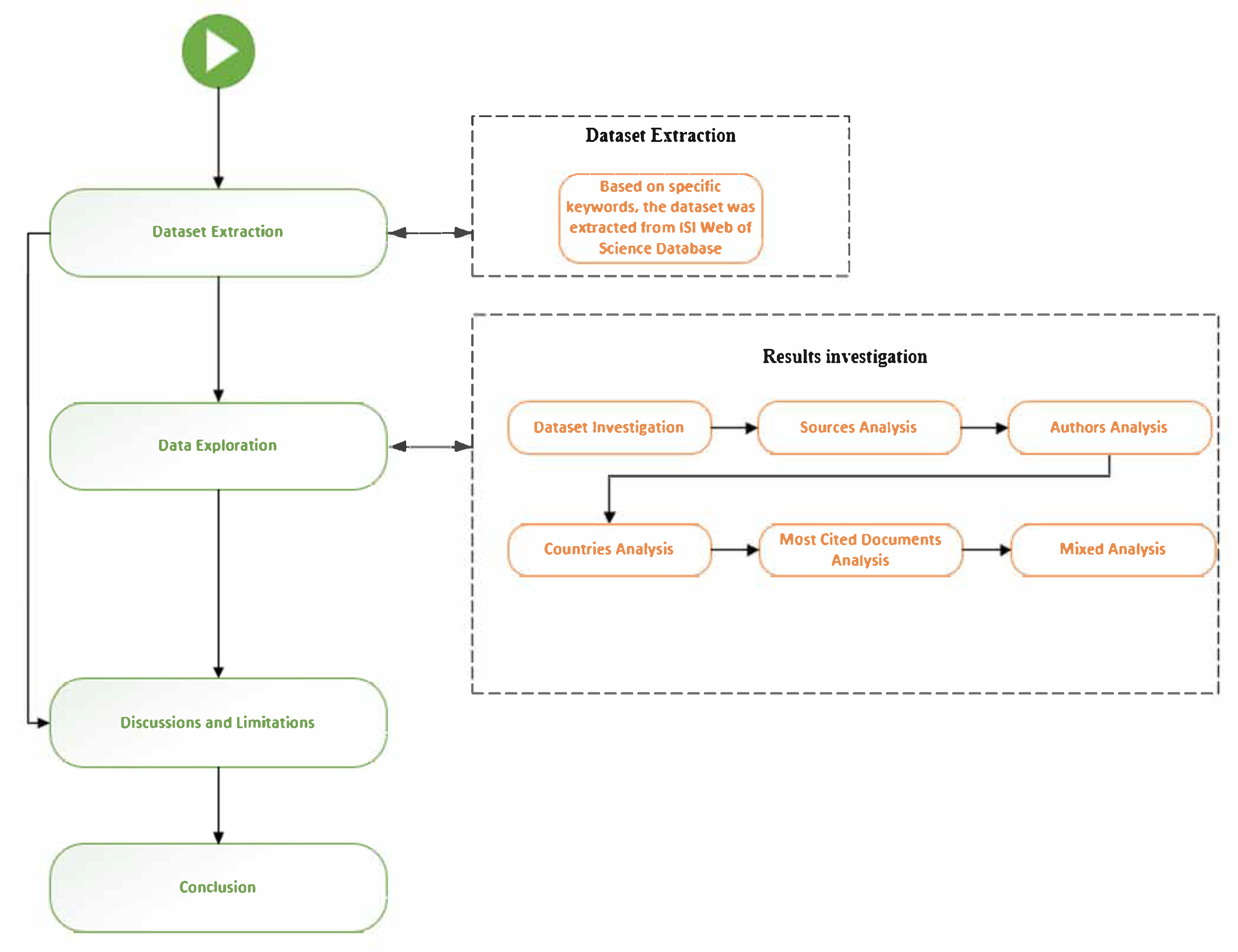

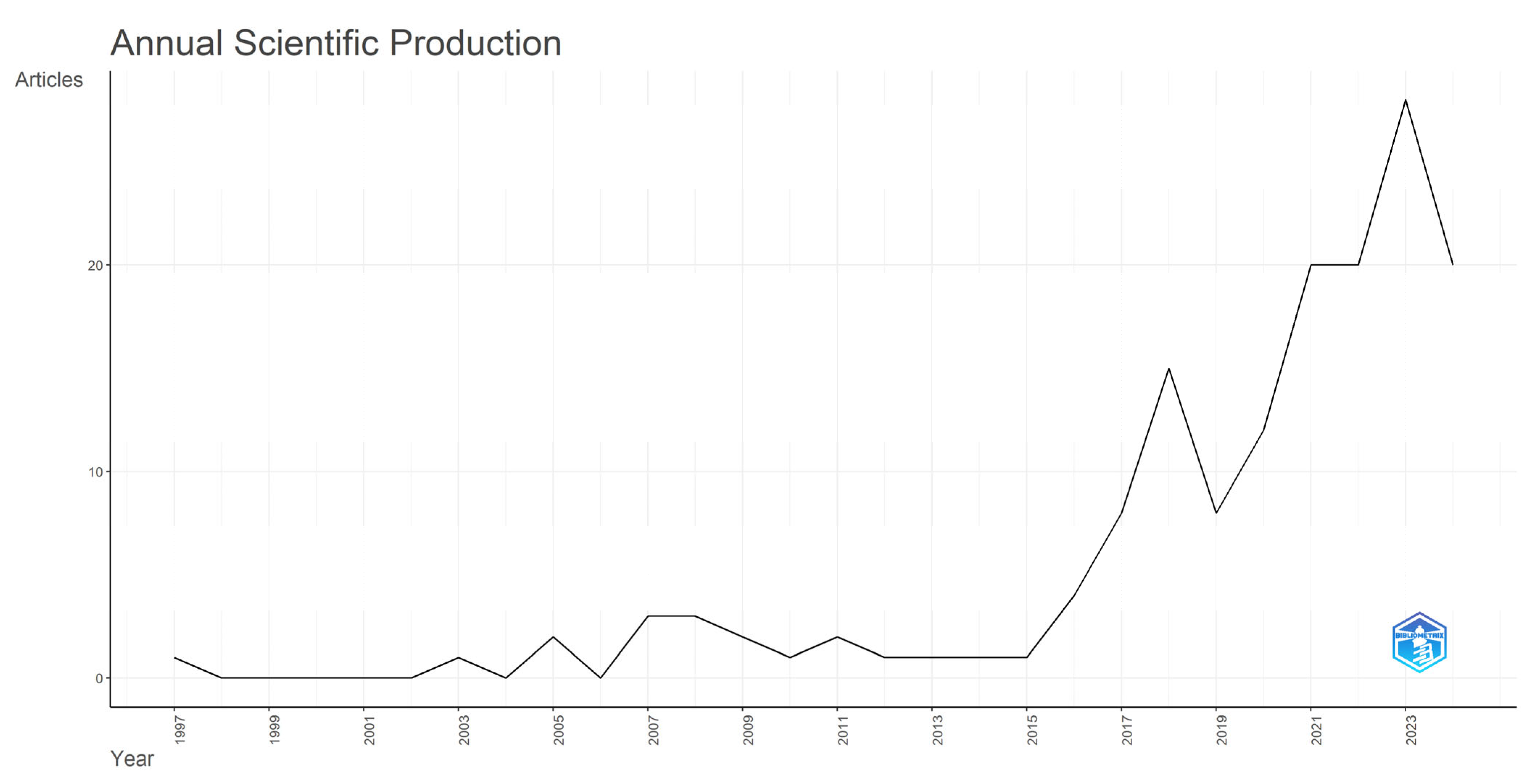

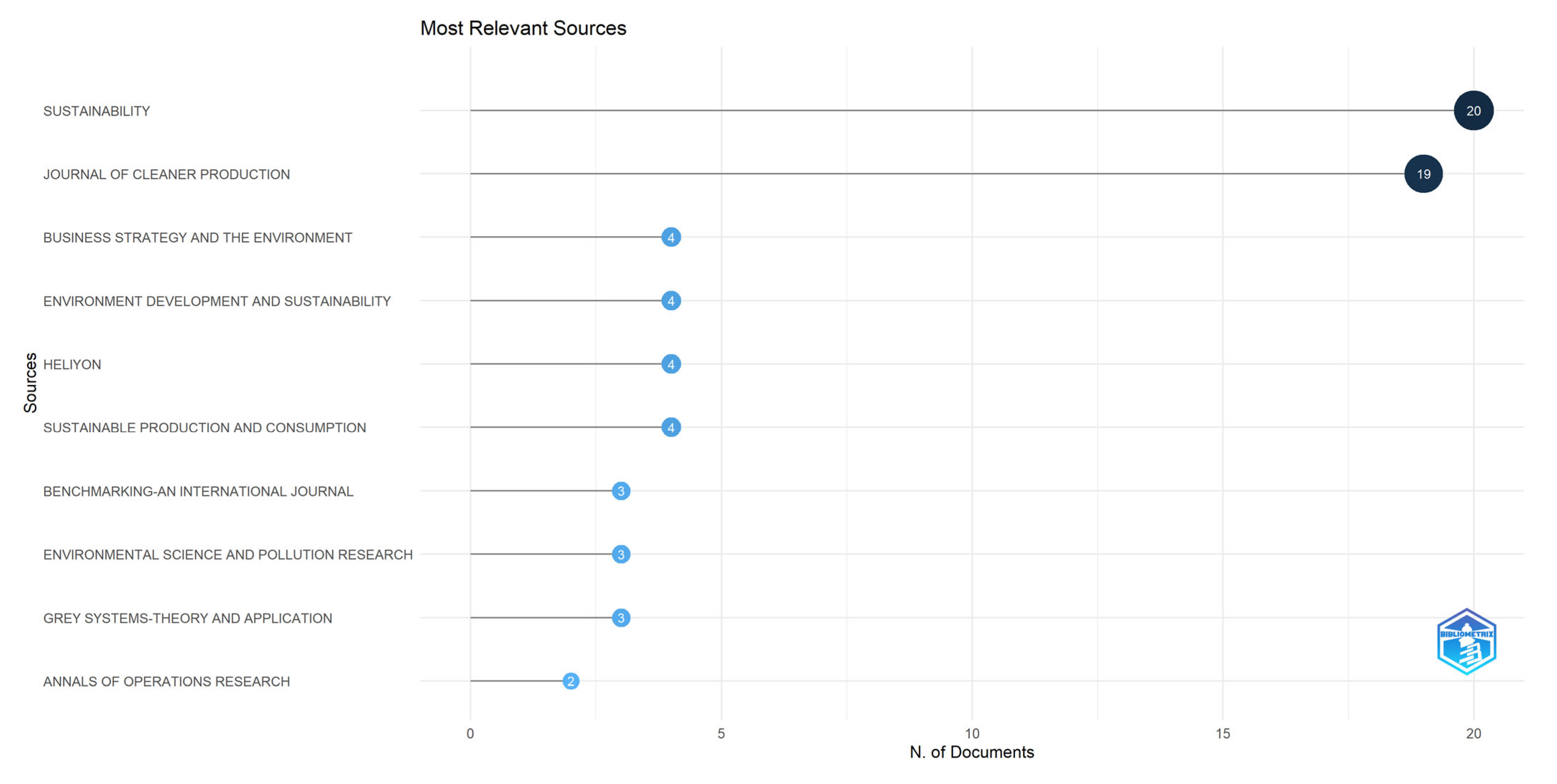
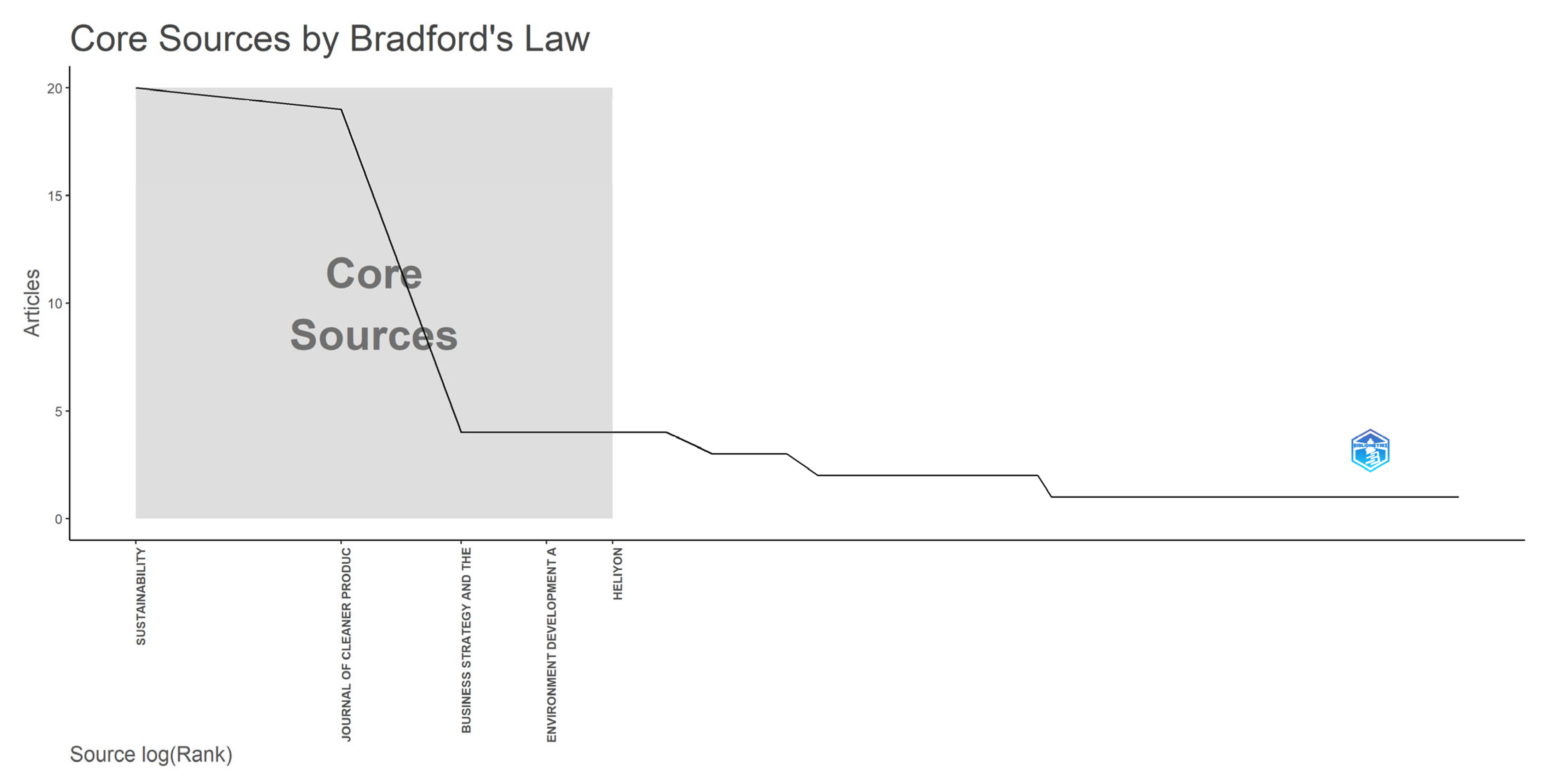

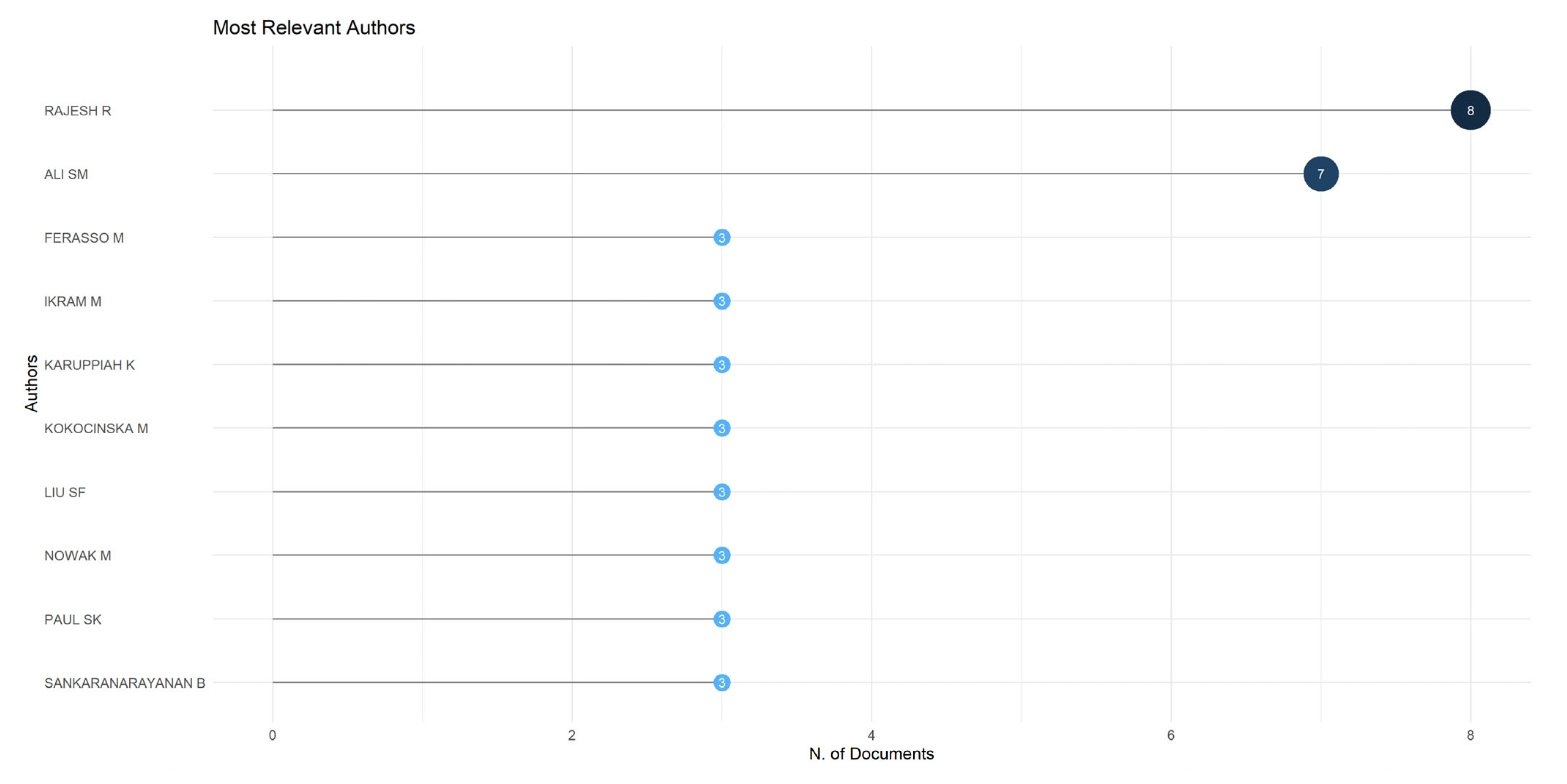
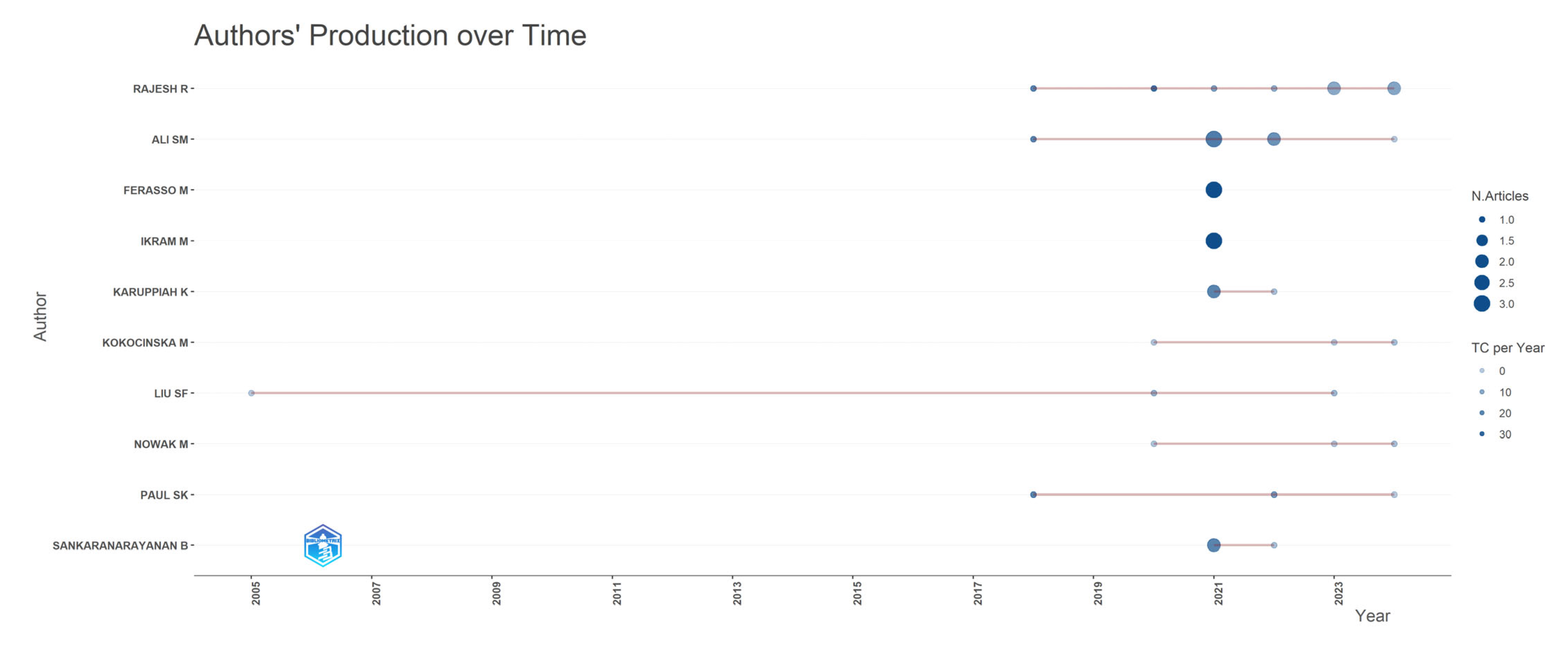

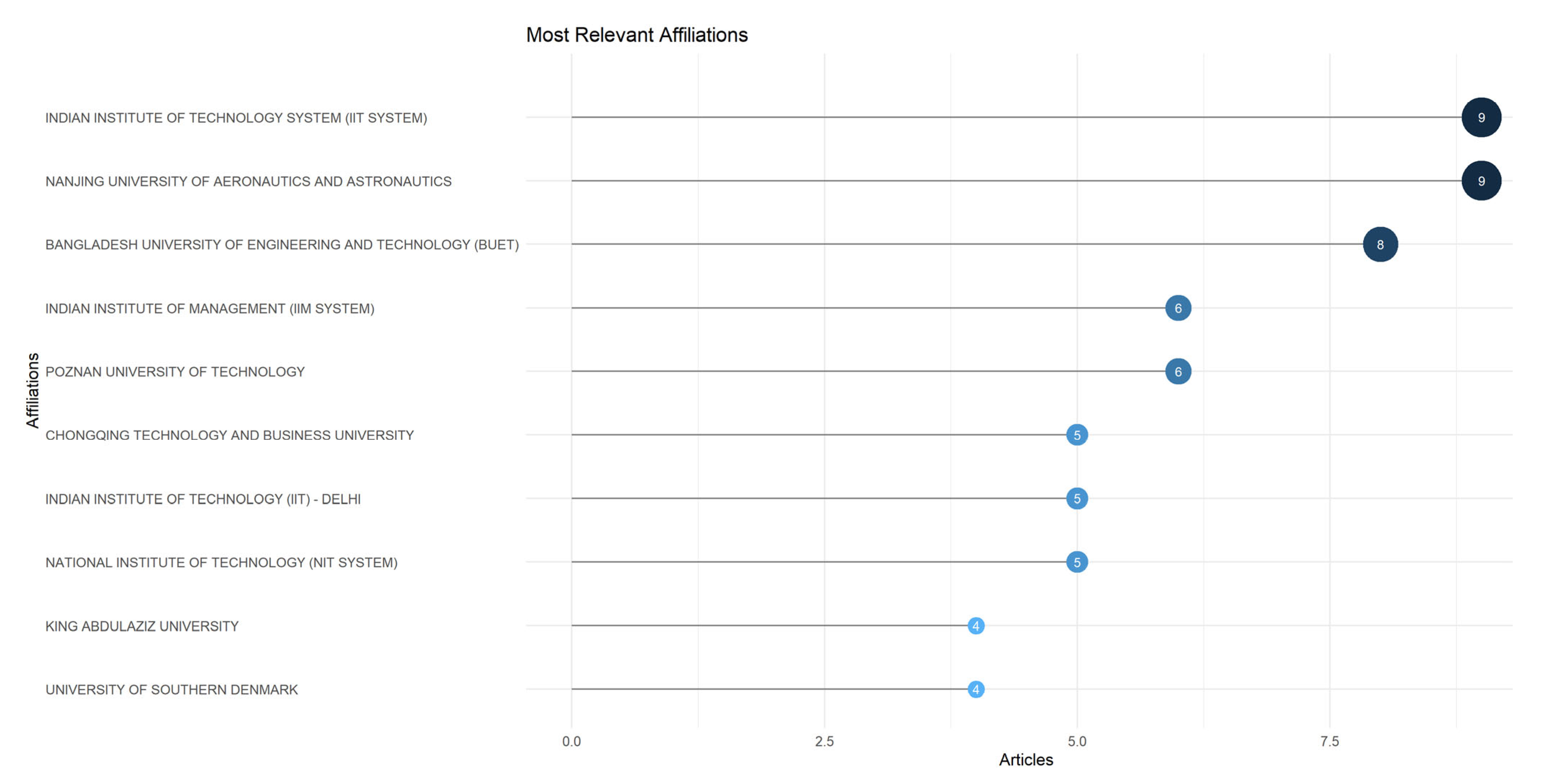
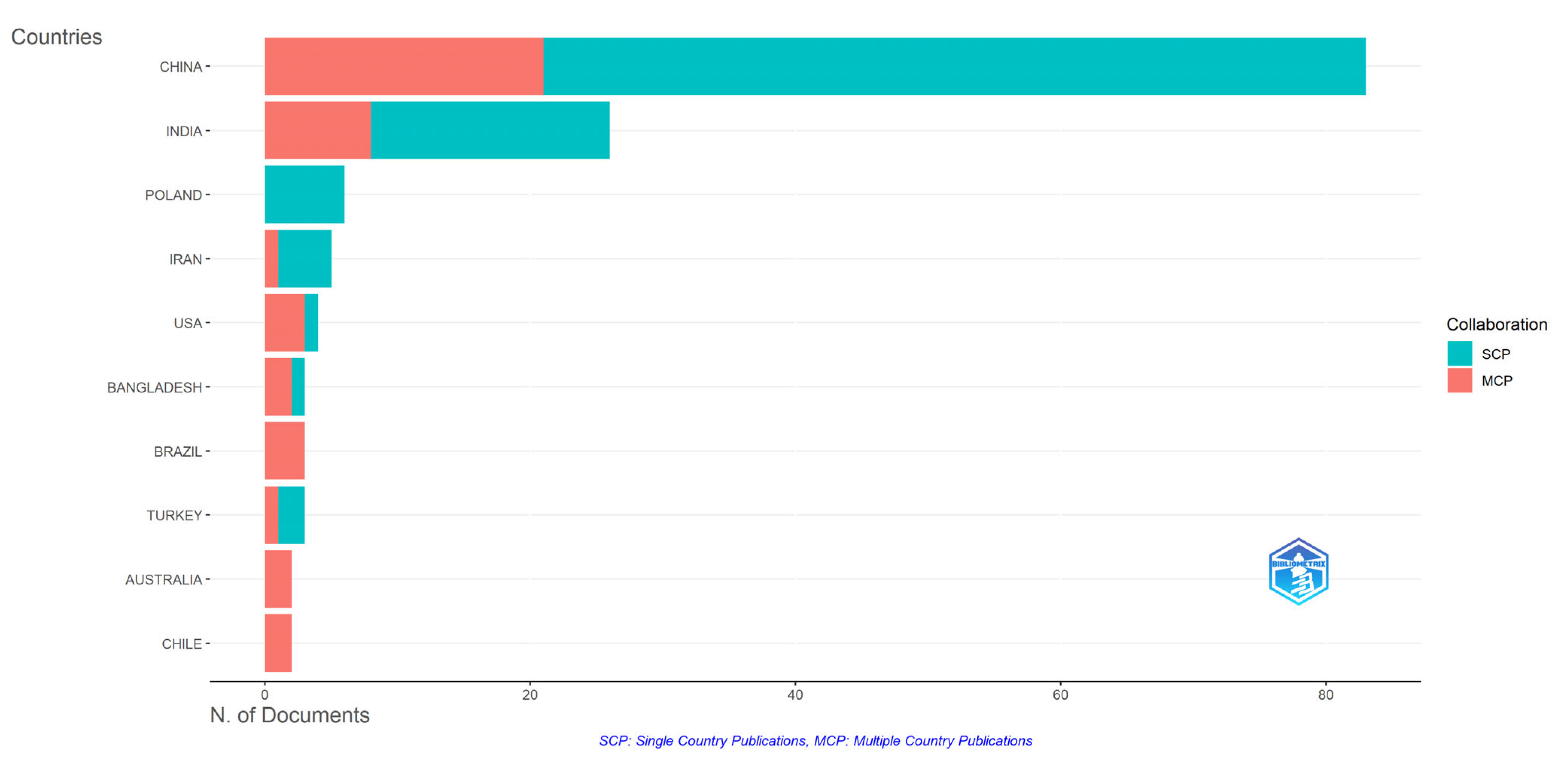


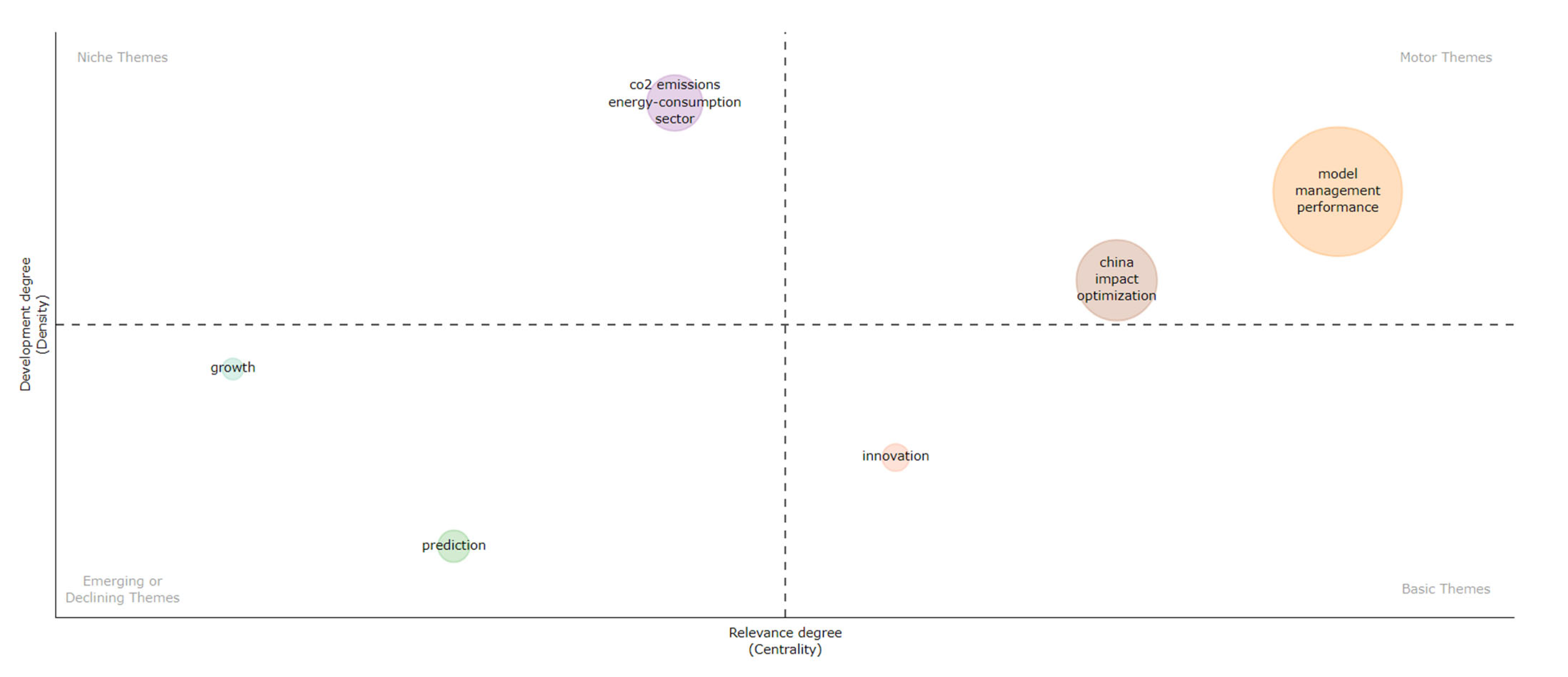
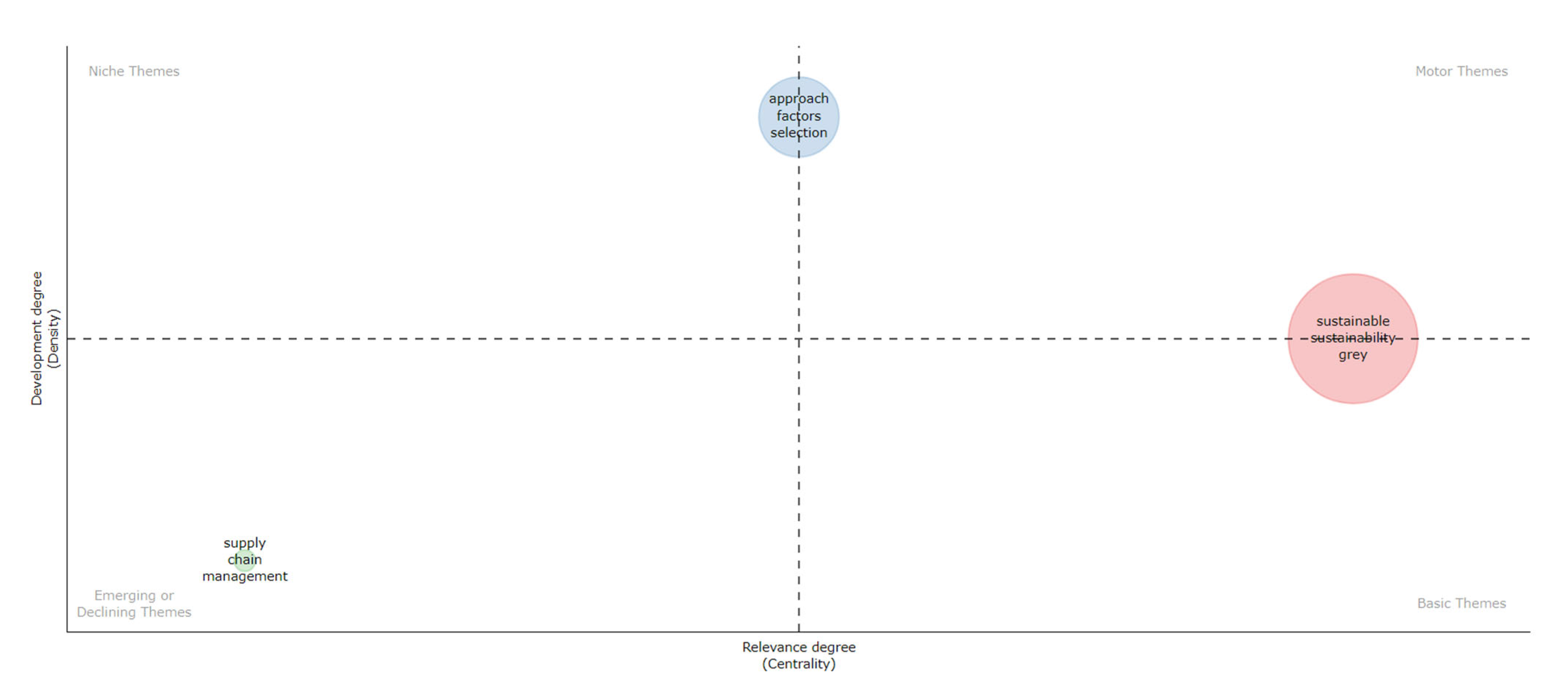
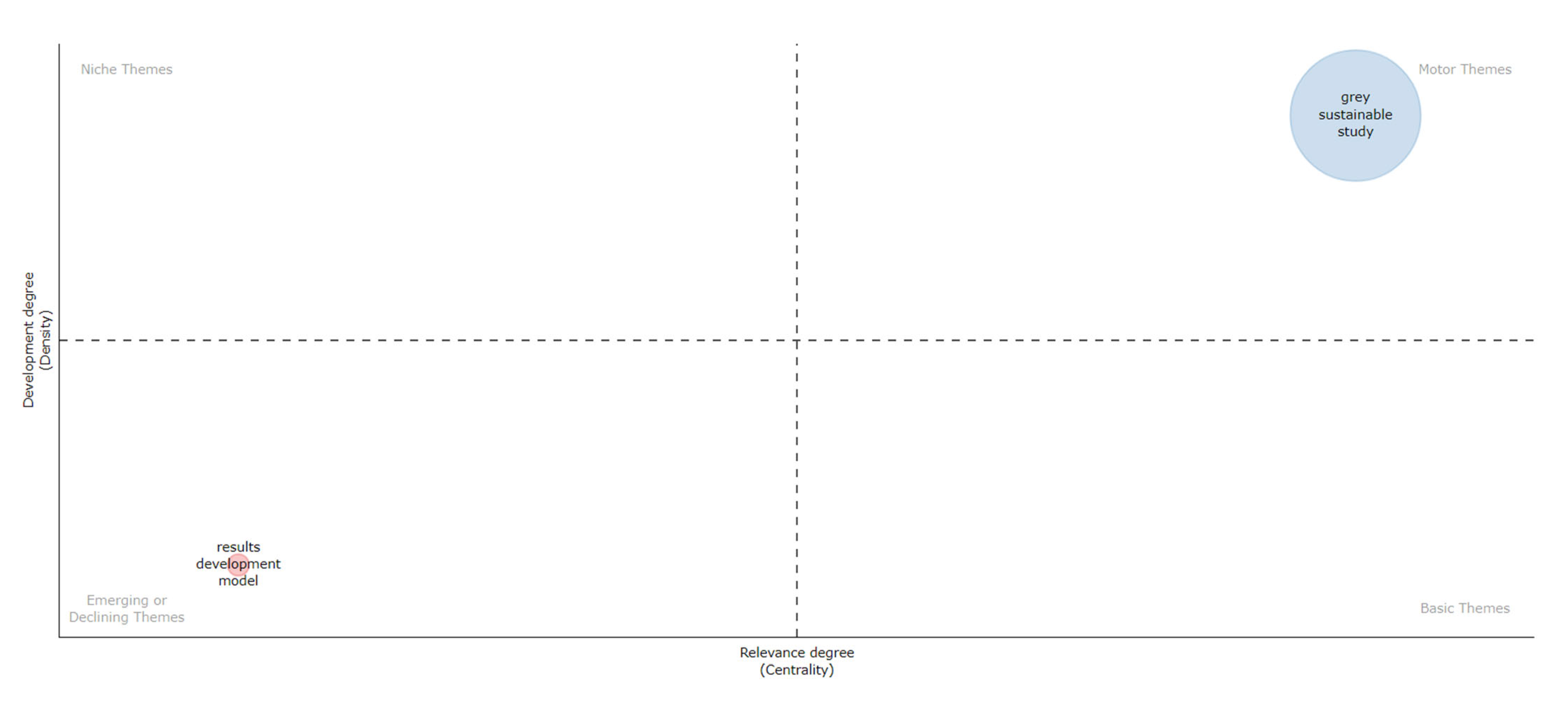

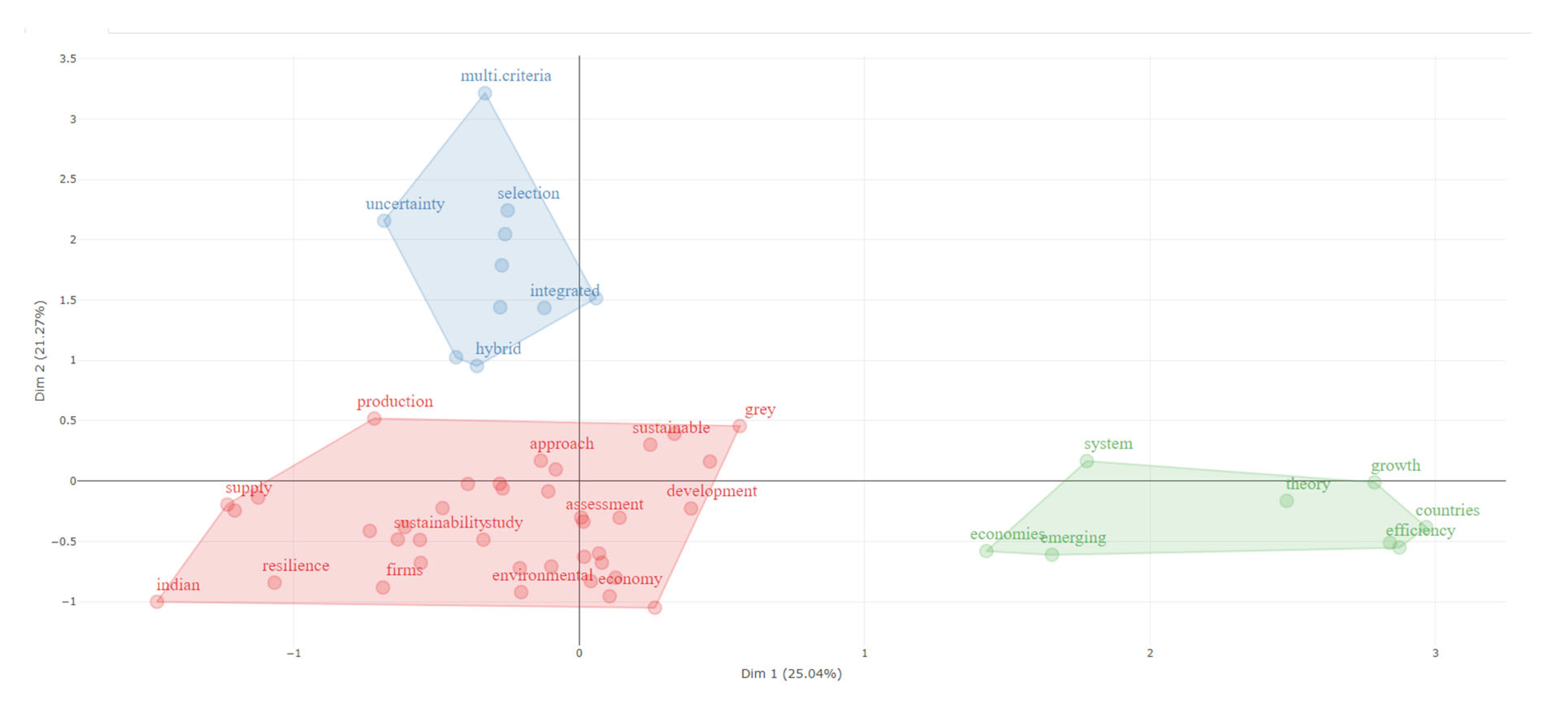
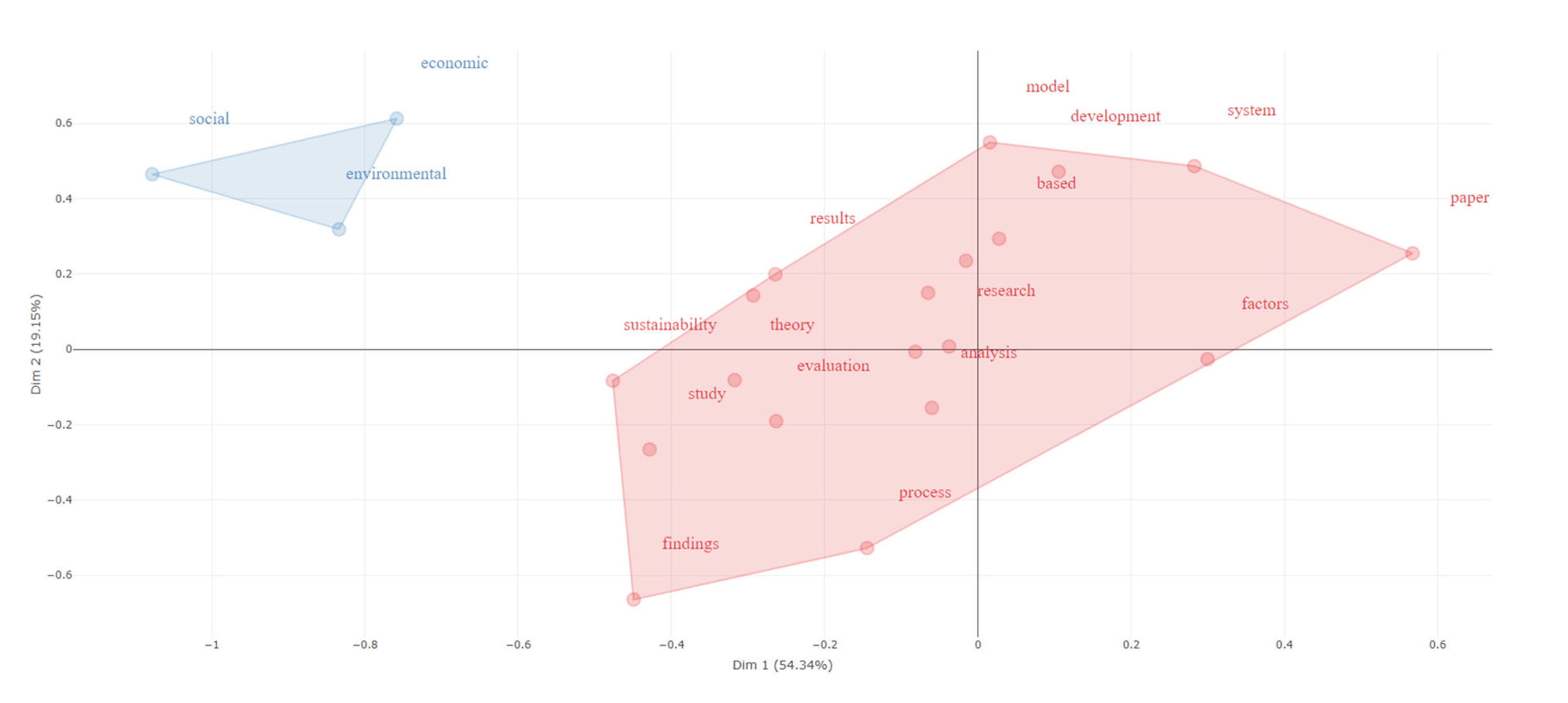
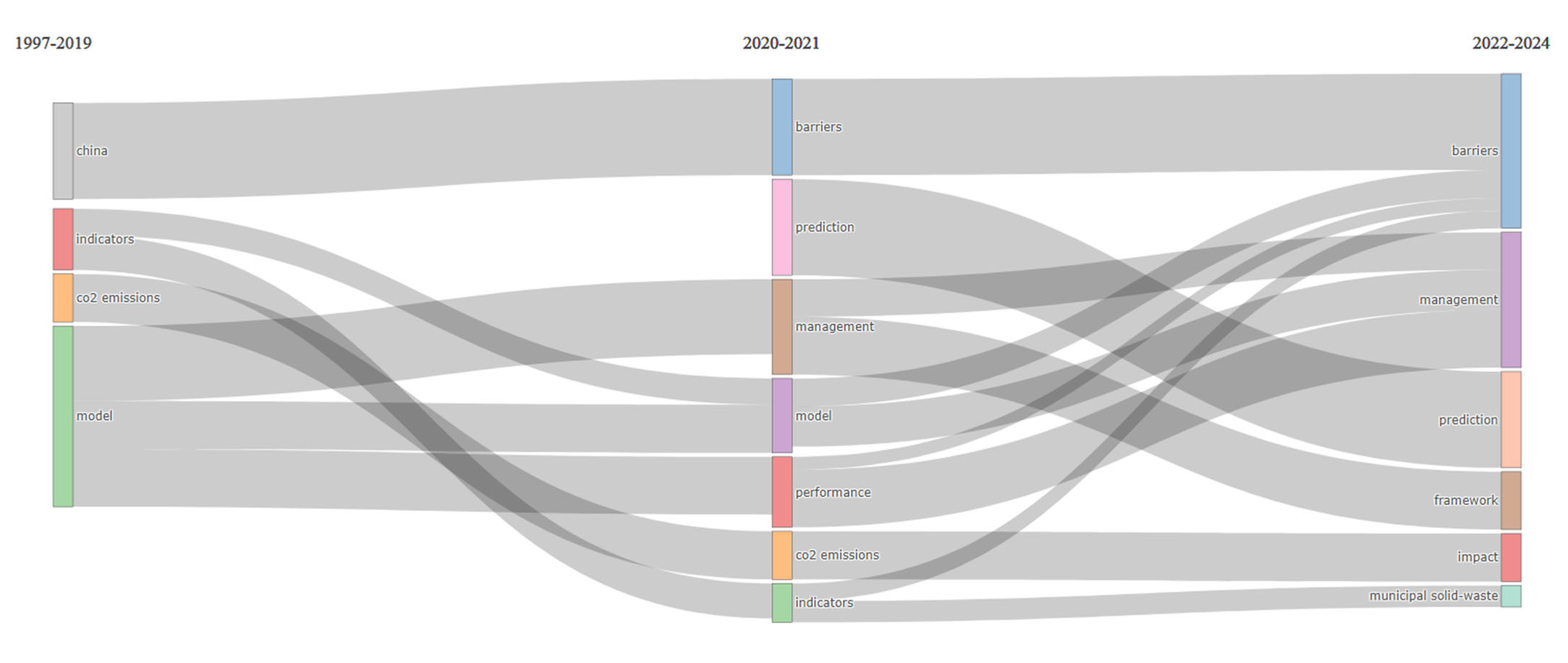
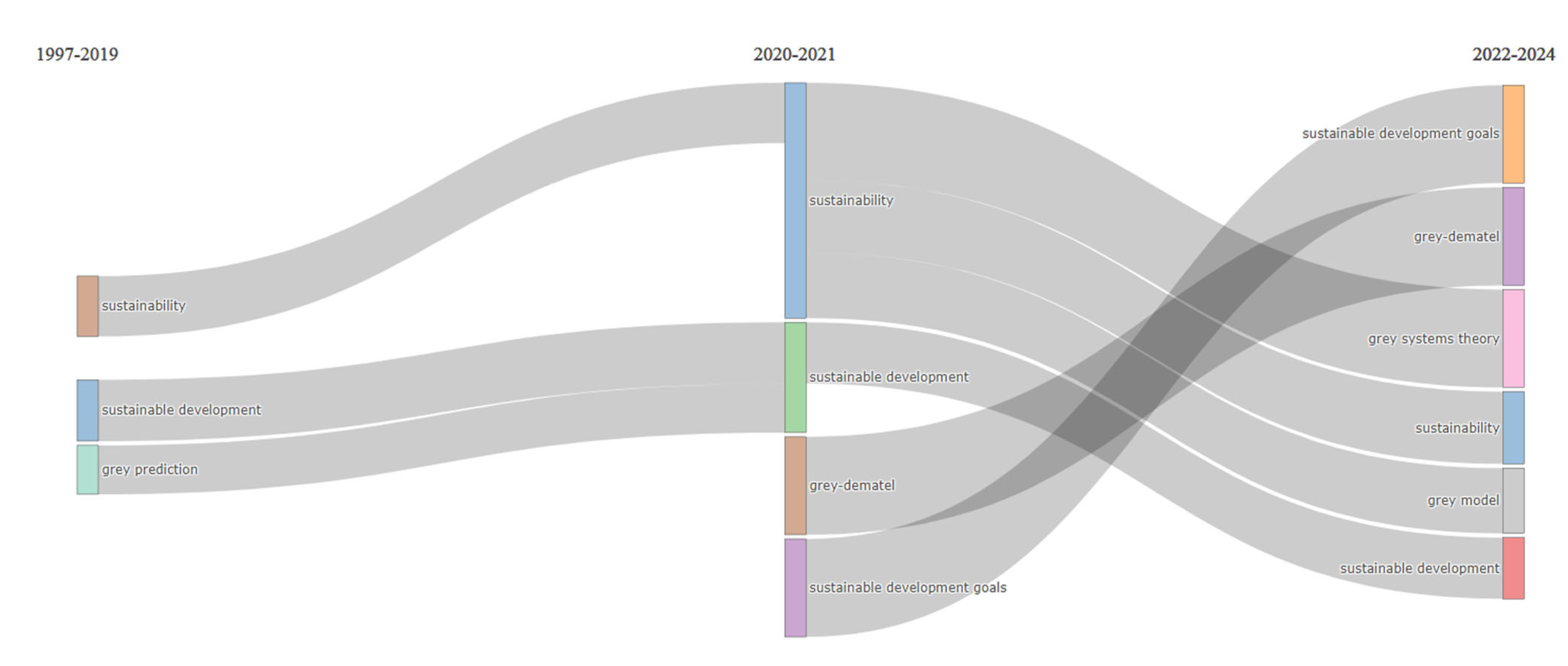

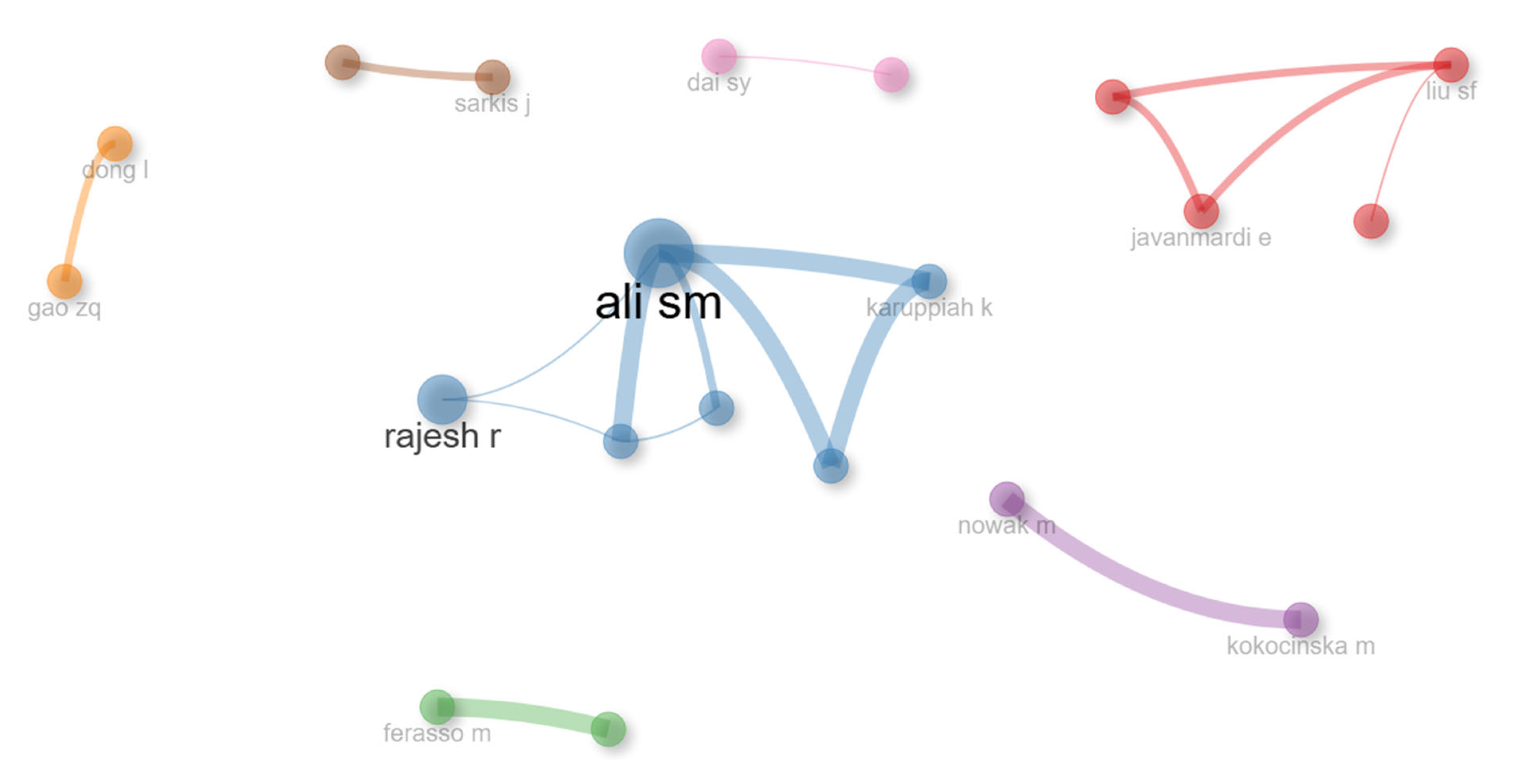
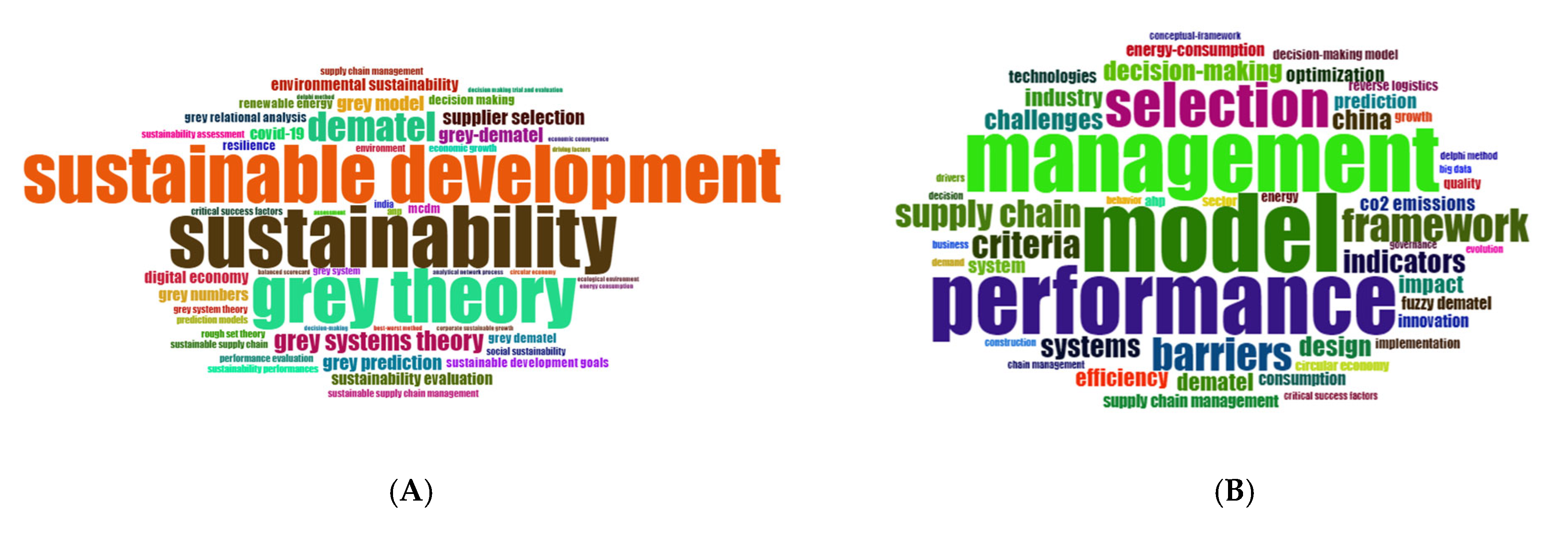
| Indicator | Value |
|---|---|
| Timespan | 1997:2024 |
| Sources | 87 |
| Documents | 154 |
| Average years from publication | 4.49 |
| Average citations per document | 25.55 |
| References | 7772 |
| No. | Paper (First Author, Year, Journal, Reference) | Number of Authors | Total Citations (TC) | Total Citations Per Year (TCY) | Normalized TC (NTC) |
|---|---|---|---|---|---|
| 1 | Bai C., 2010, International Journal of Production Economics, [50] | 2 | 592 | 37.00 | 1.00 |
| 2 | Su CM., 2016, Journal of Cleaner Production, [51] | 6 | 204 | 20.40 | 2.83 |
| 3 | Wu KJ., 2017, Journal of Cleaner Production, [52] | 6 | 173 | 19.22 | 3.46 |
| 4 | Moktadir MA., 2018, Journal of Cleaner Production, [44] | 4 | 144 | 18.00 | 3.61 |
| 5 | Rajesh R. 2020, Journal of Cleaner Production, [46] | 1 | 133 | 22.17 | 3.09 |
| 6 | Luthra S., 2018, Production Planning & Control, [53] | 5 | 125 | 15.63 | 3.14 |
| 7 | Golinska P., 2015, Journal of Cleaner Production, [54] | 4 | 105 | 9.55 | 1.00 |
| 8 | Zarbakhshnia N., 2020, Journal of Cleaner Production, [55] | 4 | 104 | 17.33 | 2.41 |
| 9 | Dong LJ., 2020, Journal of Cleaner Production, [56] | 3 | 94 | 15.67 | 2.18 |
| 10 | Wu WY., 2005, Applied Mathematics and Computation, [11] | 2 | 93 | 4.43 | 2.00 |
| No. | Paper (First Author, Year, Journal, Reference) | Title | Data | Purpose |
|---|---|---|---|---|
| 1 | Bai C., 2010, International Journal of Production Economics, [50] | Integrating sustainability into supplier selection with grey system and rough set methodologies | Metrics specific to supplier selection decision | To extend the research methodology by integrating the sustainability issue |
| 2 | Su CM., 2016, Journal of Cleaner Production, [51] | Improving sustainable supply chain management using a novel hierarchical grey-DEMATEL approach | Supplier prioritization data from a Taiwanese company | To identify relevant aspects regarding the supplier prioritization process through the hierarchical Grey decision-making method and a set of reliable criteria |
| 3 | Wu KJ., 2017, Journal of Cleaner Production, [52] | Toward sustainability: using big data to explore the decisive attributes of supply chain risks and uncertainties | Data gathered from practitioners in the Taiwanese LED (light-emitting diode) industry | To establish the impact of the risks and uncertainties of the supply chain in the context of a sustainable transition of the market |
| 4 | Moktadir MA., 2018, Journal of Cleaner Production, [44] | Modeling the interrelationships among barriers to sustainable supply chain management in leather industry | Data collected from professionals in the industry | To inspect the barriers encountered when implementing sustainable supply chain management in the Bangladeshi leather industry |
| 5 | Rajesh R. 2020, Journal of Cleaner Production, [46] | Exploring the sustainability performances of firms using environmental, social, and governance scores | Environmental, Social, and Governance (ESG) scores regarding 39 Indian firms | To analyze the sustainability performance of 39 companies from India by implementing a Grey incidence analysis in the study |
| 6 | Luthra S., 2018, Production Planning & Control, [53] | Modelling critical success factors for sustainability initiatives in supply chains in Indian context using Grey-DEMATEL | Critical Success Factors (CSFs) extracted from the literature review | To explore the causality between the factor identified as being effective in implementing sustainable actions in the Indian supply chain |
| 7 | Golinska P., 2015, Journal of Cleaner Production, [54] | Grey Decision Making as a tool for the classification of the sustainability level of remanufacturing companies | Remanufacturing indicators from previous studies and survey results | To define specific categories of companies based on the sustainability levels, in order to optimize the prioritizing process |
| 8 | Zarbakhshnia N., 2020, Journal of Cleaner Production, [55] | A novel hybrid multiple attribute decision-making approach for outsourcing sustainable reverse logistics | Survey responses from specialists in the car parts manufacturing industry | To propose a methodology that combines a fuzzy analytic hierarchy process and Grey multi-objective optimization |
| 9 | Dong LJ., 2020, Journal of Cleaner Production, [56] | Some developments and new insights for environmental sustainability and disaster control of tailings dam | Data extracted from the literature review regarding the accident statistics and method used | To compare different methods on the stability of a tailings dam, including Grey system methods, to assess the safety work and the environmental sustainability |
| 10 | Wu WY., 2005, Applied Mathematics and Computation, [11] | A prediction method using the grey model GMC(1, n) combined with the grey relational analysis: a case study on Internet access population forecast | Data concerning Taiwan’s internet access | To propose an improved prediction method that associates the Grey model and the improved Grey relational analysis |
| Bigram Titles | Frequency of Bigram Titles | Bigram Abstracts | Frequency of Bigram Abstracts |
|---|---|---|---|
| Sustainable development | 31 | Sustainable development | 112 |
| Supply chain | 13 | Supply chain | 48 |
| Supplier selection | 11 | Digital economy | 34 |
| Digital economy | 7 | Supplier selection | 32 |
| Grey system | 7 | Evaluation laboratory | 28 |
| Success factors | 5 | Prediction model | 28 |
| Economic growth | 4 | Grey model | 23 |
| Emerging economies | 4 | Water resource | 19 |
| Decision-making framework | 3 | Economic growth | 16 |
| Multi-criteria decision-making | 3 | Energy consumption | 14 |
| Trigram Titles | Frequency of Trigram Titles | Trigram Abstracts | Frequency of Trigram Abstracts |
|---|---|---|---|
| Sustainable supplier selection | 5 | Evaluation laboratory DEMATEL | 12 |
| Grey system theory | 4 | Grey systems theory | 12 |
| Supply chain management | 4 | Supply chain management | 11 |
| Chinas digital economy | 2 | Sustainable supplier selection | 9 |
| Corporate sustainable growth | 2 | Circular economy practices | 8 |
| Digital economy development | 2 | Grey decision-making trial | 8 |
| Grey prediction model | 2 | Chinas digital economy | 7 |
| Integrated multi-criteria decision-making | 2 | Natural gas industry | 5 |
| Support vector machine | 2 | Ecosystem sustainable development | 5 |
| Analyzing key factors | 1 | Analytical network process | 4 |
Disclaimer/Publisher’s Note: The statements, opinions and data contained in all publications are solely those of the individual author(s) and contributor(s) and not of MDPI and/or the editor(s). MDPI and/or the editor(s) disclaim responsibility for any injury to people or property resulting from any ideas, methods, instructions or products referred to in the content. |
© 2025 by the authors. Licensee MDPI, Basel, Switzerland. This article is an open access article distributed under the terms and conditions of the Creative Commons Attribution (CC BY) license (https://creativecommons.org/licenses/by/4.0/).
Share and Cite
Crișan, G.-A.; Domenteanu, A.; Popescu, M.E.; Delcea, C. Decision-Making for Sustainable Digitalization Through Grey Systems Theory: A Bibliometric Overview. Sustainability 2025, 17, 4615. https://doi.org/10.3390/su17104615
Crișan G-A, Domenteanu A, Popescu ME, Delcea C. Decision-Making for Sustainable Digitalization Through Grey Systems Theory: A Bibliometric Overview. Sustainability. 2025; 17(10):4615. https://doi.org/10.3390/su17104615
Chicago/Turabian StyleCrișan, Georgiana-Alina, Adrian Domenteanu, Mădălina Ecaterina Popescu, and Camelia Delcea. 2025. "Decision-Making for Sustainable Digitalization Through Grey Systems Theory: A Bibliometric Overview" Sustainability 17, no. 10: 4615. https://doi.org/10.3390/su17104615
APA StyleCrișan, G.-A., Domenteanu, A., Popescu, M. E., & Delcea, C. (2025). Decision-Making for Sustainable Digitalization Through Grey Systems Theory: A Bibliometric Overview. Sustainability, 17(10), 4615. https://doi.org/10.3390/su17104615







